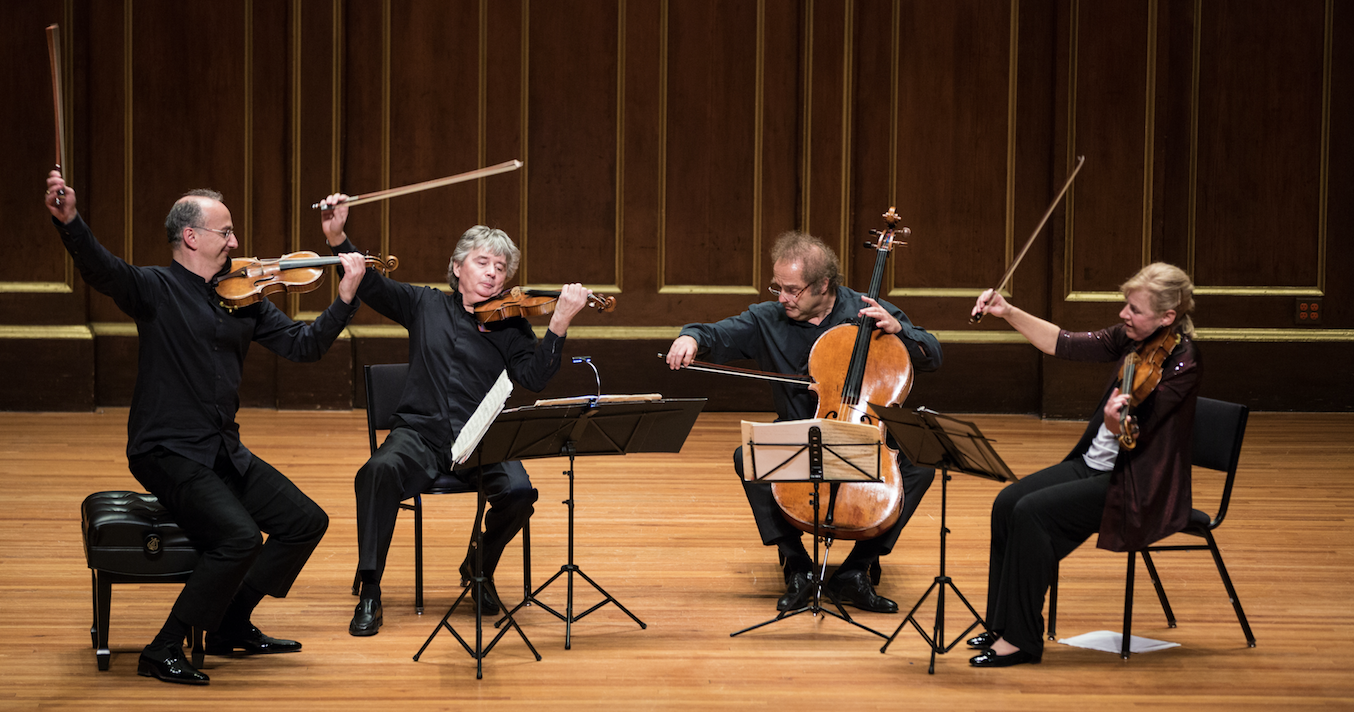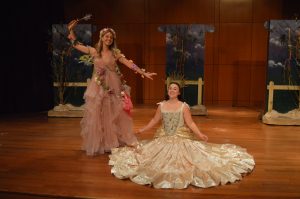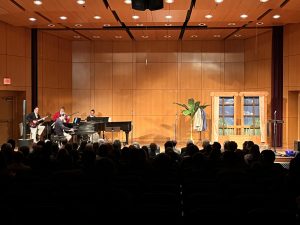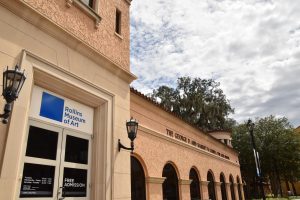(From left to right) Edward Dusiberre, Geraldine Walther, Kåroly Schranz, and Andrås Fejér blend the melodies of Mozart, Shostakovich, and Bach for the Rollins community. Photo above by Robert Torres.
Grounded in Beethoven and Mozart, the Takács Quartet served up conservative selections. But if part of the role of the modern-day string quartet is to revitalize great music of the past and submit it to the highest musicianship, the 43-year-old Takács is the undisputed standard-bearer.
The Takács Quartet returned to Tiedtke Hall for an afternoon recital Sunday, March 18 presented by the Bach Festival Society of Winter Park. The program consisted of Mozart’s Quartet No. 14 in G major, Shostakovich’s No. 11 in f minor, and Beethoven’s great No. 14 in c-sharp minor.
The opening adagio fugue of the Beethoven was something to marvel at: the individual entrances, led by the first violin, built up to a slow and meditative dirge; the arrival of the theme at the crests of the wavelike motion by which it is carried was organic and coherent. Each of the four voices came together into a unified whole, a new body of sound.
András Fejér on cello was a revelation throughout the recital. He blended in best in the higher register and, alternately, added a resonant lower end in the bass, especially in his plucked-string accompaniment.
In contrast to the mournful opening fugue, there was a bouncy playfulness in the extended andante fourth movement and elegant—technically impressive—tempo decelerations in the presto (meaning very fast) section.
Takács captured Beethoven’s lingering sense of humor in the presto, as the main theme continued to be picked up and tossed around, defying conventional developments. Here, Fejér did something quite astounding: he strained the bow near the bridge of the cello to create an acidic tone.
Furthermore, what of the desperate cries of the adagio toward the end of the 40-minute quartet? Beethoven poured out his troubled mind, not in effusive lyrical Romanticism, but in his unique fashion: the evolution of a simple motif over a long stretch of time.
The Takács musicians sifted that motivic development very thoughtfully, manipulating the flow of the phrases through time. There was both pathos and technical brilliance. More importantly, the performance achieved symbiotic flow over the uninterrupted movements: a lifelike depiction of human emotional subtleties and complexities, suspended in time.
The Shostakovich—the shortest of the three—had a kind of lopsided structural design that flowed in seven connected movements. It opened with a gelid minor-key melody for first violin, spartanly played by Edward Dusinberre on first violin.
The group was intrepid in the rough edges, of which there were plenty, as tends to be the case with Shostakovich. The abrupt dynamic shifts and frenetic cello lines were striking, especially following the serenity of the Mozart.
There was also a remarkable forte peak with all four instruments bowing in unison aggressively; hairs from Károly Schranz’s (second violin) bow were seen lashing wildly over his violin.
But as the piece traversed over its multi-part development, it ended in anti-climactic quietness, affording no ease of mind from the wintry opening gestures that inform the whole thematic design.
Although it received a solid reading, the Mozart felt more like a concert opener, subordinate to the rest of the program. Yes, there was much to savor in the Haydn-esque quartet, and it was interpreted well: the staggered iterations of the main theme in the closing molto allegro movement, or the dramatic turn to the minor mode in the menuetto.
However, we can also dispense with mainstay names like Mozart every now and then—especially when we have a Beethoven masterpiece as the main act—in favor of contemporary music, much of which has yet to see the light of day in Central Florida.
Formed in Budapest in 1975 and now based in Boulder, Colorado, the Grammy-winning quartet has undergone personnel changes over the years; now it consists of Edward Dusinberre (first violin), Geraldine Walther (viola), and founding members Károly Schranz (second violin until May, when he is scheduled to retire) and András Fejér (cello).
To learn more about upcoming Bach Festival performances, free of charge to Rollins students, faculty, and staff, visit bachfestivalflorida.org.







Be First to Comment